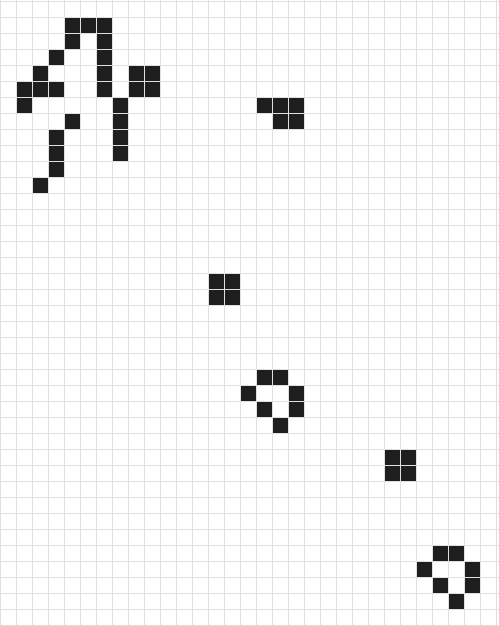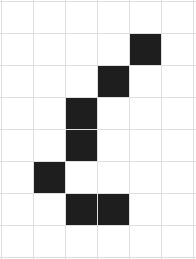Take a look at a pre-loaf and a pi:
If you run them in B37c/S23, the pre-loaf stabilizes quickly, but the pi takes a while — and some space. It needs 110 generations to settle down.
If you run them in B37e/S23, though, the pre-loaf just becomes a loaf immediately and the pi stabilizes much more quickly, in only 23 generations, and without spreading out so much.
So based on that, maybe it’s plausible B37c/S23 could be explosive while B37e/S23 isn’t. And then that might help account for why B37/S23 is explosive while B36/S23 and B38/S23 aren’t.
But this is still rather hand-wavy. Plausible is one thing, proved is something else entirely. First, it’s not just what happens to these objects that matters, but also how likely they are to arise in the first place. No matter how long and over what area a pi evolves, it won’t cause anything if it never crops up in the first place.
Second, in addition to pre-loafs and pis, you also need to consider larger sub-patterns with pre-loaves and pis embedded in them. How likely are they and what do they do under the two rules?
Anyway, proof or no proof, B37e/S23 really isn’t explosive. That means — unlike B37/S23 — it can be explored with a soup search. But apgmera, the C++ version 3 of apgsearch, can’t handle non-totalistic rules. The Python version 1.0 can, or rather a hacked version of it can. Slowly! I’ve been running it and it’s done 2 or 3 soups per second, about 3 orders of magnitude slower than apgmera can run B3/S23. And for some reason it seemed not to be sending results to Catagolue.*
But anyway, 11c/52 diagonal puffers cropped up several times, laying trails of blocks and loaves:
 This puffer evolves from this 7 cell object:
This puffer evolves from this 7 cell object: And if there’s a suitably placed ship nearby, it becomes an 11c/52 diagonal spaceship. This has cropped up in several soups.
And if there’s a suitably placed ship nearby, it becomes an 11c/52 diagonal spaceship. This has cropped up in several soups.
*Edit: My B37e/S23 hauls are on Catagolue, but under the enharmonic name B37-c/S23.

Check out rule B358/S237. It is well balanced; while it may seem to live forever, it actually dies with blinkers or still patterns, but after much much longer time than standard Conwey’s rule B3/S23. To shorten its life-time skip B8 to get B35/S237, which is good for larger grids, or if you don’t want to wait till its death.
Rule B358/S237 also occasionally forms nice still pattern, which I named a ‘Flower’ (5 x Tub pattern). The pattern distantly resembles known ‘Honey farm’ pattern (4 x Tub).
Large random soups in both B358/S237 and B35/S237 tend to (slowly) explode, filling space with dense chaos that doesn’t stabilize. Makes it hard to find interesting behavior.